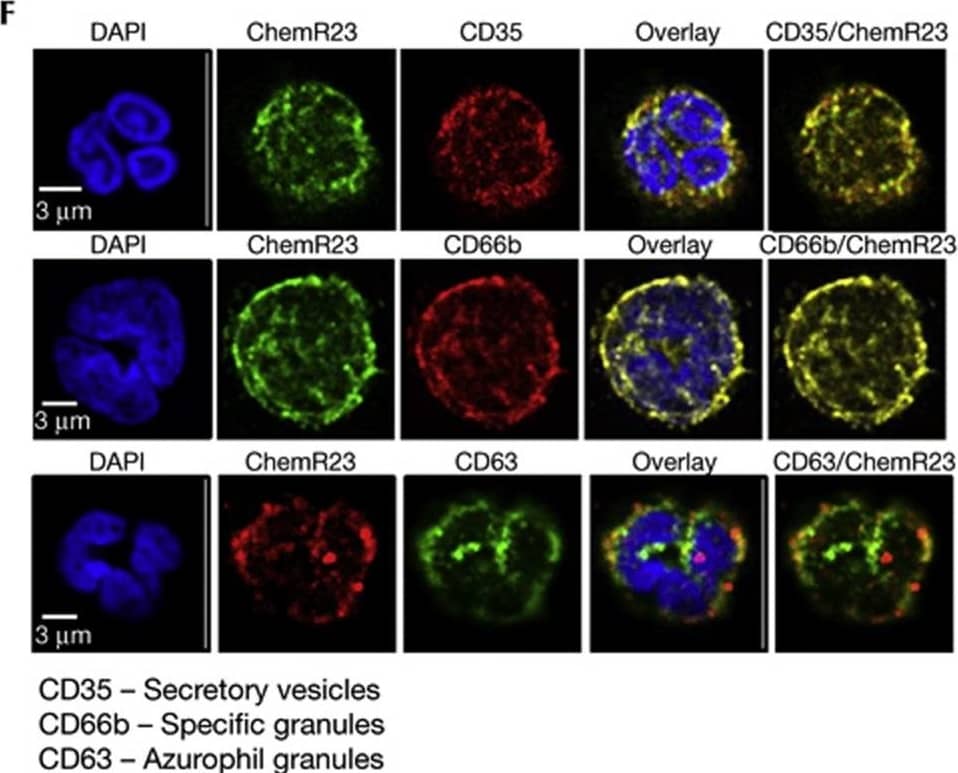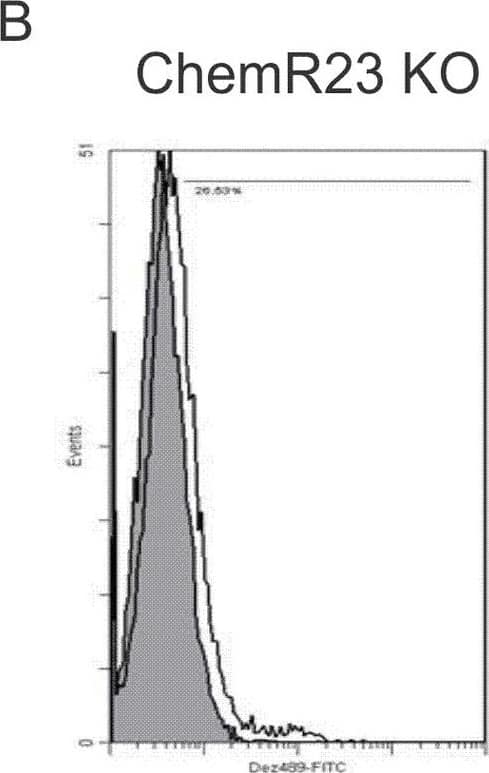Human ChemR23 Antibody
R&D Systems, part of Bio-Techne | Catalog # MAB362


Conjugate
Catalog #
Key Product Details
Species Reactivity
Validated:
Human
Cited:
Human, Mouse
Applications
Validated:
CyTOF-ready, Flow Cytometry
Cited:
Flow Cytometry, Immunocytochemistry
Label
Unconjugated
Antibody Source
Monoclonal Mouse IgG3 Clone # 84939
Product Specifications
Immunogen
NS0 mouse myeloma cell line transfected with human ChemR23
Met1-Leu371
Accession # NP_004063
Met1-Leu371
Accession # NP_004063
Specificity
Detects human ChemR23. Stains human ChemR23-transfected cells but not irrelevant transfectants.
Clonality
Monoclonal
Host
Mouse
Isotype
IgG3
Scientific Data Images for Human ChemR23 Antibody
Detection of ChemR23/CMKLR1 by Immunocytochemistry/ Immunofluorescence
Non-genomic modulation of ChemR23 expression on neutrophils (A,B) ChemR23 expression on human leukocytes was determined by flow cytometry on vehicle and TNF alpha (10 ng/ml; 20 min)-stimulated cells. Representative histograms shown in A. (C) Neutrophils were treated with vehicle, pro-inflammatory (TNF alpha; fMLF, 1 μM; IL-8, 100 ng/ml) or anti-inflammatory mediators (annexin A1, 10 nM; alphaMSH, 10 nM; C15, 10 pM) followed by staining for ChemR23. ChemR23 expression was also assessed on isolated human neutrophils before and after flow over activated endothelial cells. (D) ChemR23 expression by wild-type but not ChemR23−/− murine neutrophils. (E) Permeabilized human neutrophils were stained with anti-ChemR23 (with goat-anti-mouse Alexa 488 secondary) and wheat germ agglutinin (WGA-Alexa 647) to visualize the cell membrane. Cells were analysed by confocal microscopy. (F) Human neutrophils were stained for ChemR23 and markers of secretory vesicles (CD35), specific granules (CD66b) and azurophil granules (CD63). (G) Neutrophils were loaded with Fura2-AM and calcium flux responses elicited by control (ionomycin), vehicle, ChemR23 inhibitor (CCX2005, 100 nM), C15 (10 pM), scrambled C15 (C15-S; 10 pM) or chemerin (1 nM). Responses are displayed as deltaF340/F380. Graphs show mean values±s.e.m. from three to six independent experiments. *P<0.05 relative to vehicle-treated or pre-flow cells. alphaMSH, alpha-melanocyte-stimulating hormone; IL-8, interleukin-8; TNF alpha, tumour necrosis factor alpha. Image collected and cropped by CiteAb from the following open publication (https://pubmed.ncbi.nlm.nih.gov/23999103), licensed under a CC-BY license. Not internally tested by R&D Systems.Detection of ChemR23/CMKLR1 by Immunocytochemistry/ Immunofluorescence
Non-genomic modulation of ChemR23 expression on neutrophils (A,B) ChemR23 expression on human leukocytes was determined by flow cytometry on vehicle and TNF alpha (10 ng/ml; 20 min)-stimulated cells. Representative histograms shown in A. (C) Neutrophils were treated with vehicle, pro-inflammatory (TNF alpha; fMLF, 1 μM; IL-8, 100 ng/ml) or anti-inflammatory mediators (annexin A1, 10 nM; alphaMSH, 10 nM; C15, 10 pM) followed by staining for ChemR23. ChemR23 expression was also assessed on isolated human neutrophils before and after flow over activated endothelial cells. (D) ChemR23 expression by wild-type but not ChemR23−/− murine neutrophils. (E) Permeabilized human neutrophils were stained with anti-ChemR23 (with goat-anti-mouse Alexa 488 secondary) and wheat germ agglutinin (WGA-Alexa 647) to visualize the cell membrane. Cells were analysed by confocal microscopy. (F) Human neutrophils were stained for ChemR23 and markers of secretory vesicles (CD35), specific granules (CD66b) and azurophil granules (CD63). (G) Neutrophils were loaded with Fura2-AM and calcium flux responses elicited by control (ionomycin), vehicle, ChemR23 inhibitor (CCX2005, 100 nM), C15 (10 pM), scrambled C15 (C15-S; 10 pM) or chemerin (1 nM). Responses are displayed as deltaF340/F380. Graphs show mean values±s.e.m. from three to six independent experiments. *P<0.05 relative to vehicle-treated or pre-flow cells. alphaMSH, alpha-melanocyte-stimulating hormone; IL-8, interleukin-8; TNF alpha, tumour necrosis factor alpha. Image collected and cropped by CiteAb from the following open publication (https://pubmed.ncbi.nlm.nih.gov/23999103), licensed under a CC-BY license. Not internally tested by R&D Systems.Detection of ChemR23/CMKLR1 by Flow Cytometry
Competition binding assays on BMDCs.[A, B] FACS analysis showing the cell surface expression of mChemR23/Dez on BMDCs generated from wild-type or ChemR23−/− mice. Cells were incubated with an anti-mChemR23 antibody (open histogram) or a control isotype (filled histogram). [C, D] Competition binding assays were performed on BMDCs generated from wild-type (C) or ChemR23−/− mice (D). Purified cells were incubated with 0.2 nM 125I-CXCL12 as tracer, and CXCL12 (300 nM), chemerin (300 nM) or a monoclonal anti-CXCR4 antibody (10 µg/ml) as competitors. After one hour incubation, unbound tracer was separated by filtration and filters washed twice before counting. The data were normalized for non-specific binding (0%) and specific binding in the absence of competitor (100%). Statistical significance as compared to the 100% values was tested by two-way analysis of variance followed by Tukey's test (***, P<0.001; **, P<0.01). All data points were performed in triplicate and the displayed data are the mean of five experiments performed with three independent cell preparations (error bars indicate S.E.M.). Image collected and cropped by CiteAb from the following open publication (https://pubmed.ncbi.nlm.nih.gov/23469143), licensed under a CC-BY license. Not internally tested by R&D Systems.Applications for Human ChemR23 Antibody
Application
Recommended Usage
CyTOF-ready
Ready to be labeled using established conjugation methods. No BSA or other carrier proteins that could interfere with conjugation.
Flow Cytometry
2.5 µg/106 cells
Sample: Human peripheral blood monocytes
Sample: Human peripheral blood monocytes
Formulation, Preparation, and Storage
Purification
Protein A or G purified from hybridoma culture supernatant
Reconstitution
Reconstitute at 0.5 mg/mL in sterile PBS. For liquid material, refer to CoA for concentration.
Formulation
Lyophilized from a 0.2 μm filtered solution in PBS with Trehalose. *Small pack size (SP) is supplied either lyophilized or as a 0.2 µm filtered solution in PBS.
Shipping
Lyophilized product is shipped at ambient temperature. Liquid small pack size (-SP) is shipped with polar packs. Upon receipt, store immediately at the temperature recommended below.
Stability & Storage
Use a manual defrost freezer and avoid repeated freeze-thaw cycles.
- 12 months from date of receipt, -20 to -70 °C as supplied.
- 1 month, 2 to 8 °C under sterile conditions after reconstitution.
- 6 months, -20 to -70 °C under sterile conditions after reconstitution.
Background: ChemR23
References
- Samson, M. et al. (1998) Eur. J. Immunol. 28:1689.
Long Name
Chemokine-like Receptor 1/Orphan G Protein-coupled Receptor ChemR23
Alternate Names
cmklr1, Dez, Gpcr27
Gene Symbol
CMKLR1
UniProt
Additional ChemR23 Products
Product Documents for Human ChemR23 Antibody
Product Specific Notices for Human ChemR23 Antibody
For research use only
